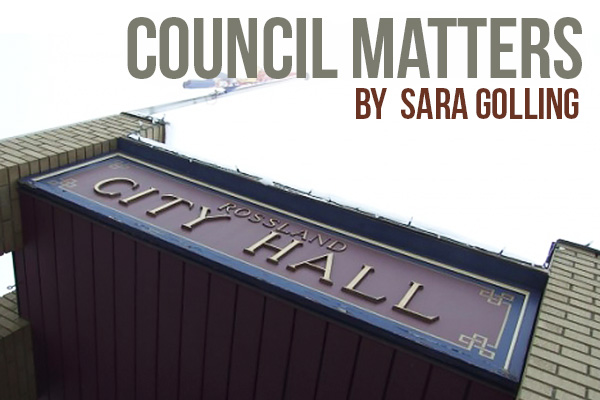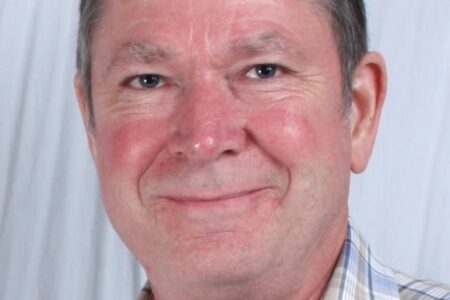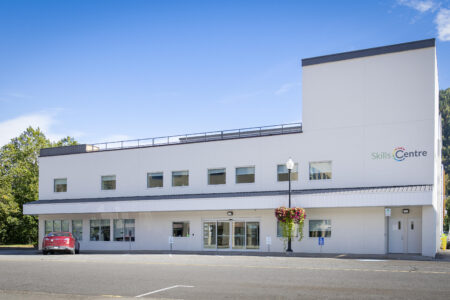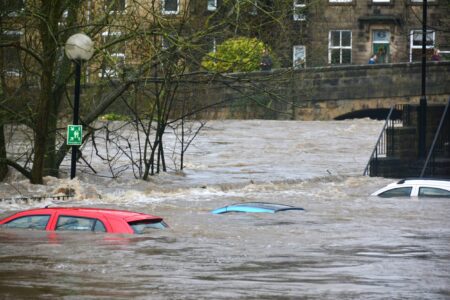Money and the City
Council gets its teeth into some meaty financial issues. Decisions made at Committee-of-the-Whole meetings are not final until passed by resolution at a regular meeting, but Committee-of-the -Whole meetings give Council an opportunity for less-formal and more extensive discussion.
Rossland City Council, Committee-of-the-Whole Meeting, January 5, 2015
Present: Mayor Kathy Moore, and Councillors John Greene, Lloyd McLellan, Marten Kruysse, Andy Morel, Andrew Zwicker, and Aaron Cosbey. Staff: Acting CAO Tracey Butler, Manager of Public Works Darrin Albo, and Acting Chief Financial Officer Lois Hunter.
Public Input Period:
Ann Damude spoke for the Rossland Council for Arts and Culture. On Jan 11, from 4:00 to 8:00 pm, there will be a tour of the Miners Hall attic. Councillors are invited, and there will be a public consultation. Then, speaking for the Sustainability Commission, Damude spoke about the strategic planning session scheduled for January 28, from 5:30 to 9:00 pm, at the Seven Summits Centre for Learning.
The Meaning of Capital Expenditure
Council began discussion on the 2015 — 2019 Draft Financial Plan, starting with capital expenditure. Hunter presented information.
Hunter explained that “capital expenditure” means spending a substantial amount of money on assets — not operating expenses. The City needs to create a coherent, long-term asset management plan to guide its acquisition, maintenance sand disposal of capital assets.
Hunter explained that the Province formerly managed much municipal business; for example, the Province used to conduct water quality testing and then tell municipalities what to do about it and when; now, managing water quality is just one of the many responsibilities (and costs) the Provincial government has downloaded to municipal governments.
Risk and Infrastructure
Hunter talked about the City’s responsibility to manage risk, and gave as one example the state of the Miners Hall roof: if a strong enough wind roared through town, the roof could blow off. That could cause damage to people and to other properties. It’s a known risk, so if it happened, insurance could refuse to cover the resulting damage. If a stop sign is covered by tree branches, the City could possibly be liable if an accident resulted from that. The insurance provider has said we should have the reservoirs fenced off, but fencing would be a large expense, and maintaining it would be an ongoing large expense. The rebar and concrete are beginning to fail in our ancient swimming pool, which will eventually begin to leak. Some of our park playground equipment is not up to safety codes. All of these things need attention at some point.
Morel asked how our insurer assesses our risk, and sets our premiums. Butler answered that the Municipal Insurance Association (MIA) comes every year, but the City chooses what to have them assess. Premiums are based on our claims history with MIA. Capri Insurance holds our insurance for buildings & properties. McLellan asked if there have been any claims in the past five years. Butler responded that there have been some claims related to the building bylaw, at Redstone, and a slip & fall claim.
Hunter moved on to discussing asset management. In 2011, the City had a consultant — CTQ — in to look at infrastructure and identify high-priority needs. They prioritized projects and set out a proposed schedule for completing them, but the City is now well behind that schedule.
Hunter proposed a method for catching up. She presented a spreadsheet entitled “Capital Funding Envelope” which showed actual spending on capital projects — infrastructure — from 2009 to the present, and projected the amounts the City needs to spend from now to the end of 2019, in order to address urgent infrastructure needs. Hunter pointed out that it is much more cost-effective to replace crumbling infrastructure before it fails catastrophically and requires expensive emergency repairs. She pointed out that when politicians feel under heavy pressure to keep property taxes low, they tend to put off infrastructure repair and replacement — and that results in higher costs (and higher taxes, and a less liveable community) later on.
Hunter mentioned that in the past, the Province used to reward communities for failing to keep their infrastructure in good repair by offering funds to help with the resulting emergencies; now, the Province is promoting good asset management. She described her catch-up plan as “a little ambitious” but said it would give the City a good start. The City now has a Reserves Bylaw which will help keep Council focused on the goal of keeping up infrastructure and having necessary reserves in place.
Cosbey asked whether the emergency infrastructure repairs just done in Pinewood would have been prevented by doing the project on the schedule set out in the CTQ report; Albo answered, yes — the repairs would not have been needed if the project has been done earlier. Cosbey asked why the work was not done; Moore responded that Council felt pressure to keep taxes low. Cosbey noted that the advantage of doing the infrastructure projects “as they come due is that you don’t deal with them as crises, and they cost less”; Albo and Hunter agreed. Hunter gave the Thompson Avenue culvert failure as another example of high cost incurred because of failure to replace or maintain infrastructure.
How to pay for it all?
Hunter discussed funding options. A 1% increase in the municipal portion of property taxes would raise a small amount annually; Hunter reminded us that our property tax bills also contain a number of taxes that do not come to the City — there are the Regional District Levy, the school tax, hospital and police costs, and so on. The City just collects those taxes and passes them on.
Water and sewer fees and charges are supposed to fund those systems completely; currently, ours do not, but there is a consultant coming to do an evaluation and suggest an improved rate structure.
Taking on more debt is an option for helping to cover infrastructure needs, but is expensive, and a municipality’s credit rating goes down as its debt goes up. Borrowing more money only delays paying for infrastructure renewal.
Municipalities receive funds from a “gas tax” which must be spent on infrastructure. Rossland is now assured of receiving gas tax funds of about $193,000 per year until 2024. Hunter suggests using the gas tax income to provide the “seed money” required for grant applications, but pointed out that we cannot count on getting substantial grants needed for infrastructure. She then discussed upcoming grant applications, and sought Council’s decision on which projects to apply for under the grants. After lengthy discussion on the grants, their criteria, how to have the best chance of success, and the City’s urgent need for all three infrastructure projects, Council voted unanimously to accept the staff recommendations about the grant applications.
Council getting up to speed
When Hunter asked for Council’s guidance on a few projects (such as an expenditure of $300,000 for a de-humidifier for the arena), a number of Council members indicated that they didn’t feel prepared to make decisions on particular items with long-term implications without first having more information, reading more of the relevant reports, and doing strategic planning. They discussed the need to complete their budget in good time, but as a new Council, they need to do some catching up first. Moore acknowledged that they will “struggle” with this first budget. McLellan pointed out that they don’t yet know how the discussions about regional recreation will go, or what it might cost that should be included in a budget. Kruysse commented that producing a 5-year plan in the absence of new information is a “dumb idea.”
Cosbey, addressing the urgent need for infrastructure work, said that the City might need to take on some additional debt on a short-term basis, as it may save money to avoid spending more “in crisis mode”. McLellan agreed with Cosbey, saying that if we don’t get a grant for the Washington Street project, borrowing may be cost-effective because failing to do the project “is really risky.” Zwicker suggested having a Committee-of-the-Whole meeting to “hash out our top several priorities.”
Council discussed at some length their next steps toward the budget. Moore commented that she thinks this Council is dedicated to reducing the infrastructure deficit, and there was agreement around the table. Kruysse noted that one of Council’s challenges is how to involve the public.
Council then looked at a list of 18 “special projects” and received information about the level of need for each. Two examples from the list: replacing rip-rap that vandals have ripped off the face of Ophir dam, and completing smoke testing to discover leakage and infiltration in sewer pipes.
RDKB Expenses
Hunter went on to introduce the subject of Regional District costs and how they affect taxes for Rossland property owners. The Regional District charges Rossland for sewer costs, and we pay those on our utility bills and tax bills. Apart from sewer costs, we pay the Regional District a separate Regional District Levy which covers a long list of other services — including $490,232 for Fire Services, $88,568 for regional solid waste management, $113,656 for “Culture, Arts & Recreation in the Lower Columbia”, $180,378 for “East end Transit”, and $55,993 for “General Government Services”. The total amount expected to be charged to Rossland for our RDBK levy for 2015 is $977,390. You’ll notice that the Fire Services charge accounts for just over half of that total.
Rotary Building
Council discussed at length various options for the old Rotary building, owned by the City and currently on the market, listed for $120,000. A motion to demolish it and create a parking lot for the Miners Hall failed; a motion to sell the building also failed; Zwicker moved that Council create a land and property strategy so that Council could make decisions about its properties with its higher-level goals in mind. The motion carried. Meanwhile, the building remains on the market.
Highway safety
A citizen had written a letter to Council about the safety of the intersection of the highway and Redstone Drive. That intersection is the responsibility of the Provincial department of Highways, who approved the design. Albo expressed sympathy for drivers making a left turn from Redstone Drive in the winter, as there is often a slight snow berm left from plowing, which adds to the difficulty of getting across the downhill lanes of traffic travelling at 70 kmh.
Moore adjourned the meeting at 8:00 pm.
Your reporter shuffled cautiously home in the dark along LeRoi Avenue, contemplating one of the capital projects on the City’s work plan, which may eventually result in a sidewalk along LeRoi from Davis Street to Spokane Street — “the LeRoi hill” — and wondering whether a sidewalk would actually be an improvement in the winter, when sidewalks can be treacherously icy and the main roadways are nicely plowed and sanded. What do you think — would a sidewalk there be better, or not?

























